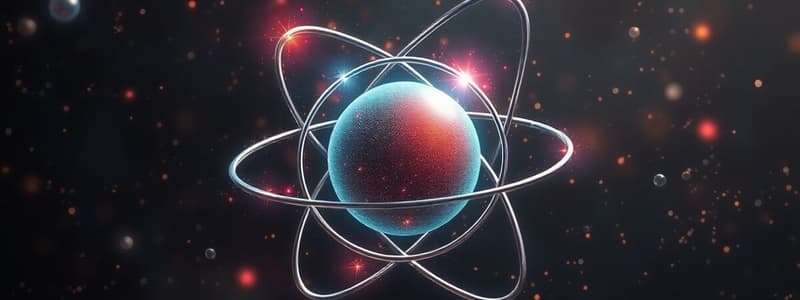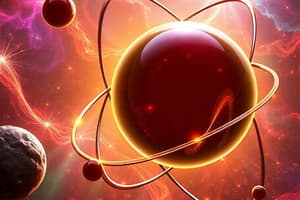Podcast
Questions and Answers
Which scientist proposed that all matter is composed of extremely small particles called atoms?
Which scientist proposed that all matter is composed of extremely small particles called atoms?
- J.J. Thompson
- John Dalton (correct)
- Ernst Rutherford
- Democritus
What did J.J. Thompson discover about the structure of the atom?
What did J.J. Thompson discover about the structure of the atom?
- Electrons are negatively charged particles. (correct)
- Atoms consist only of neutrons.
- Atoms are indivisible.
- Atoms have a dense nucleus.
What does the Law of Definite Proportions state?
What does the Law of Definite Proportions state?
- Compounds can vary in proportions.
- All atoms of an element have different properties.
- Elements can combine in fixed ratios. (correct)
- Atoms cannot be subdivided.
What was Max Planck's contribution to atomic theory?
What was Max Planck's contribution to atomic theory?
Which scientist is known for the Planetary Model of the atom?
Which scientist is known for the Planetary Model of the atom?
What did Rutherford's Gold Foil Experiment demonstrate about the atom?
What did Rutherford's Gold Foil Experiment demonstrate about the atom?
How did Albert Einstein explain the photoelectric effect?
How did Albert Einstein explain the photoelectric effect?
According to early atomic theory, what feature of atoms was emphasized by Dalton?
According to early atomic theory, what feature of atoms was emphasized by Dalton?
What significant conclusion did Rutherford reach from his experiments regarding atomic structure?
What significant conclusion did Rutherford reach from his experiments regarding atomic structure?
How did Niels Bohr contribute to the understanding of electron behavior in atoms?
How did Niels Bohr contribute to the understanding of electron behavior in atoms?
What theory did Max Planck introduce regarding energy emission and absorption?
What theory did Max Planck introduce regarding energy emission and absorption?
What is the implication of the Law of Definite Proportions in terms of atomic composition in compounds?
What is the implication of the Law of Definite Proportions in terms of atomic composition in compounds?
Which model depicts the atom as having a positive mass with negatively charged electrons dispersed throughout it?
Which model depicts the atom as having a positive mass with negatively charged electrons dispersed throughout it?
What is the key idea of Dalton's atomic theory regarding elements?
What is the key idea of Dalton's atomic theory regarding elements?
Which particle did Rutherford hypothesize must exist alongside protons in the atomic nucleus?
Which particle did Rutherford hypothesize must exist alongside protons in the atomic nucleus?
What did Albert Einstein's explanation of the photoelectric effect reveal about light?
What did Albert Einstein's explanation of the photoelectric effect reveal about light?
Flashcards
Atom
Atom
The smallest indivisible unit of matter. In ancient Greek, atomos literally means uncuttable.
Dalton's Atomic Theory
Dalton's Atomic Theory
A theory suggesting that all matter is made up of tiny particles called atoms. They cannot be subdivided or destroyed.
Plum Pudding Model
Plum Pudding Model
A model of the atom that resembles a plum pudding with electrons embedded in a positively charged sphere.
Nucleus
Nucleus
Signup and view all the flashcards
Rutherford's Nuclear Model
Rutherford's Nuclear Model
Signup and view all the flashcards
Quantum
Quantum
Signup and view all the flashcards
Bohr's Planetary Model
Bohr's Planetary Model
Signup and view all the flashcards
Einstein's Photon Model
Einstein's Photon Model
Signup and view all the flashcards
What is an atom?
What is an atom?
Signup and view all the flashcards
Who was Democritus?
Who was Democritus?
Signup and view all the flashcards
What is Dalton's Atomic Theory?
What is Dalton's Atomic Theory?
Signup and view all the flashcards
What is the key idea behind Dalton's Atomic Theory?
What is the key idea behind Dalton's Atomic Theory?
Signup and view all the flashcards
What is the Plum Pudding Model?
What is the Plum Pudding Model?
Signup and view all the flashcards
What did Rutherford discover?
What did Rutherford discover?
Signup and view all the flashcards
What is a quantum of energy?
What is a quantum of energy?
Signup and view all the flashcards
Who is Niels Bohr?
Who is Niels Bohr?
Signup and view all the flashcards
Study Notes
Atomic Theory
- Democritus hypothesized that matter could be divided into smaller and smaller pieces until a point where it could no longer be divided. He called this indivisible piece an atom.
- John Dalton proposed that all matter is composed of atoms.
- Atoms of the same element are identical in size, mass, and chemical properties.
- Atoms of different elements are different.
- Atoms cannot be subdivided, created or destroyed.
- Atoms combine in whole number ratios to form compounds.
J.J. Thomson
- Discovered negatively charged particles (electrons)
- Proposed the plum pudding model, describing atoms as a sphere of positive charge with negatively charged electrons embedded within it.
Ernest Rutherford
- Conducted the gold foil experiment.
- Discovered a dense, positively charged nucleus at the center of the atom.
- Proposed the nuclear model of the atom, with electrons orbiting the nucleus.
- Suggested the existence of the neutron, a neutral particle in the nucleus that contributes to the mass of the atom.
Rutherford's Experimental Design
- Alpha particles (positively charged) are directed at a thin gold foil.
- Most alpha particles passed straight through, suggesting that atoms are mostly empty space.
- Some alpha particles were deflected, indicating a dense, positively charged nucleus. Alpha particles were deflected by a positive nucleus.
Max Planck
- Observed that excited gases under low pressure emit light at specific wavelengths (line spectra), indicating that energy is emitted in discrete quantities.
- Introduced the concept of quanta, the smallest packet of energy that can be absorbed or emitted.
Niels Bohr
- Proposed the planetary model of the atom, with electrons orbiting the nucleus in specific, allowed energy levels.
- Electrons can only exist in specific energy levels (quantized energy).
Albert Einstein
- Explained the photoelectric effect, suggesting that light behaves as a stream of particles (photons).
- Each photon has a specific energy, and if this energy is high enough, it can cause an electron to jump to a higher energy level.
Louis de Broglie
- Proposed that electrons, like light, possess both wave-like and particle-like properties (wave-particle duality).
Erwin Schrödinger
- Developed a model where electrons are described by probability distributions (orbitals) rather than precise paths.
- Electrons are found in regions of space called orbitals, where the probability of finding them is highest.
- The concept of precisely determining an electron's location and momentum is impossible (Uncertainty Principle). The position or momentum of an electron cannot be precisely determined simultaneously (Uncertainty Principle).
Homework Assignment
- Read pages 143-146.
- Answer questions 1-3, 10 on page 147.
- Read pages 148-151.
- Answer questions 1, 3 on page 152.
Studying That Suits You
Use AI to generate personalized quizzes and flashcards to suit your learning preferences.




